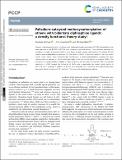Files in this item
Palladium–catalysed methoxycarbonylation of ethene with bidentate diphosphine ligands : a density functional theory study
Item metadata
| dc.contributor.author | Ahmad, Shahbaz | |
| dc.contributor.author | Crawford, L. Ellis | |
| dc.contributor.author | Buehl, Michael | |
| dc.date.accessioned | 2020-10-28T11:30:47Z | |
| dc.date.available | 2020-10-28T11:30:47Z | |
| dc.date.issued | 2020-10-13 | |
| dc.identifier | 270704923 | |
| dc.identifier | 10bd07b6-a1e1-48c5-adce-87c246e111b3 | |
| dc.identifier | 85095799897 | |
| dc.identifier | 000585861500014 | |
| dc.identifier.citation | Ahmad , S , Crawford , L E & Buehl , M 2020 , ' Palladium–catalysed methoxycarbonylation of ethene with bidentate diphosphine ligands : a density functional theory study ' , Physical Chemistry Chemical Physics , vol. Advance article . https://doi.org/10.1039/D0CP04454G | en |
| dc.identifier.issn | 1463-9076 | |
| dc.identifier.other | ORCID: /0000-0002-1095-7143/work/82179240 | |
| dc.identifier.uri | https://hdl.handle.net/10023/20845 | |
| dc.description | Authors thank EaStCHEM and the School of Chemistry for support. | en |
| dc.description.abstract | Catalytic methoxycarbonylation of ethene with a bidentate tertiary phosphine (DTBPX) and palladium has been explored at the B3PW91-D3/PCM level of density functional theory. Three different pathways for formation of methyl propanoate (MePro) have been studied, namely carbomethoxy (A), ketene (B) and hydride-hydroxyalkylpalladium pathways (C), the latter of which is favoured because it has the lowest overall kinetic barrier. After intermolecular methanolysis, a hydroxyalkylpalladium complex has been characterised on pathway C, which eventually leads to the low overall barrier to produce MePro. The possibility of copolymerisation leading to oligo-/polymers has also been considered. With a computed selectivity of >99% towards the formation of MePro and a reasonably low overall kinetic barrier of 23.0 kcal mol-1, pathway C appears to be the most plausible one. Consistent with experimental data, the overall barrier increases to 30.1 kcal mol-1 for a less bulky bidentate phosphine | |
| dc.format.extent | 7 | |
| dc.format.extent | 2781052 | |
| dc.language.iso | eng | |
| dc.relation.ispartof | Physical Chemistry Chemical Physics | en |
| dc.subject | Methoxycarbonylation | en |
| dc.subject | Alkenes | en |
| dc.subject | Carbonylation | en |
| dc.subject | Density functional calculations | en |
| dc.subject | Homogeneous catalysis | en |
| dc.subject | Methyl propanoate | en |
| dc.subject | Palladium | en |
| dc.subject | Reaction mechanisms | en |
| dc.subject | QD Chemistry | en |
| dc.subject.lcc | QD | en |
| dc.title | Palladium–catalysed methoxycarbonylation of ethene with bidentate diphosphine ligands : a density functional theory study | en |
| dc.type | Journal item | en |
| dc.contributor.institution | University of St Andrews. School of Chemistry | en |
| dc.contributor.institution | University of St Andrews. EaSTCHEM | en |
| dc.identifier.doi | https://doi.org/10.1039/D0CP04454G | |
| dc.description.status | Peer reviewed | en |
This item appears in the following Collection(s)
Items in the St Andrews Research Repository are protected by copyright, with all rights reserved, unless otherwise indicated.

